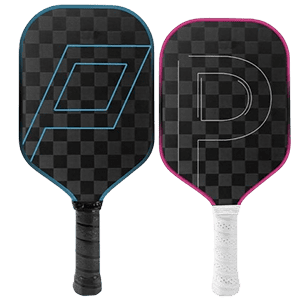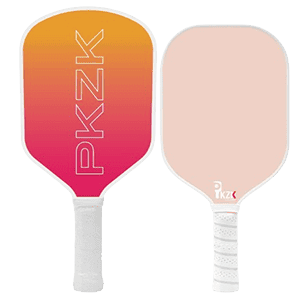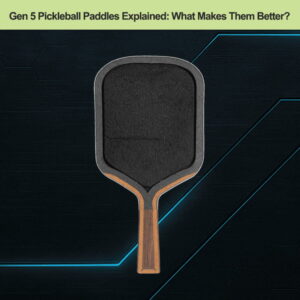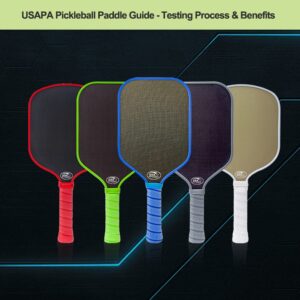
Einführung
Wenn Sie Ihre eigene Paddelleine bauen, sollten Sie den Unterschied zwischen Pickleball-Schläger aus Kohlefaser und Glasfaser ist einer der wichtigsten Schritte. Diese beiden Materialien haben nicht nur Einfluss darauf, wie ein Paddel aussieht, sondern auch darauf, wie es sich anfühlt, wie es funktioniert und wie es sich verkauft.
Kohlefaser wird häufig in High-End-Paddles verwendet, die auf Kontrolle und lang anhaltenden Spin ausgerichtet sind, während Glasfaser für seine lebendige Kraft und sein fehlerverzeihendes Gefühl bekannt ist. Jedes Material hat seine eigenen Stärken und ist für verschiedene Spielertypen, Preisklassen und Produktstrategien besser geeignet.
In diesem Leitfaden erläutern wir die wichtigsten Unterschiede zwischen Kohlefaser- und Glasfaserpaddeln aus Sicht der Herstellung und des Brandings. Unabhängig davon, ob Sie ein OEM-Käufer, eine Paddelmarke oder ein Großhändler sind, werden Sie klare Antworten finden, die Ihnen helfen, das richtige Material, die richtige Konstruktion und die richtigen Spezifikationen für Ihre nächste Produkteinführung zu wählen.
Was jedes Material für Ihre Paddelleine bedeutet
Kohlefaser (CF) - Kontrolle, Spin und erstklassiges Spielgefühl

- Wie es sich spielt: Carbonfaser hat eine steifere Schlagfläche, was weniger Flex beim Kontakt bedeutet. Dies gibt den Spielern mehr Kontrolle, geradere Schläge und ein glattes, stabiles Gefühl - vor allem bei Rückschlägen und Blocks.
- Schleuderleistung: Rohes/texturiertes Karbon hält die Oberflächenreibung über lange Zeit aufrecht, sodass der Spin auch nach monatelangem Spiel konstant bleibt. Es ist eine großartige Wahl, wenn Sie den Langzeitspin zu einem Teil Ihrer Produktgeschichte machen wollen.
- Am besten geeignet für: Pro-Level- oder Premium-Modelle. Die Kosten sind zwar höher als bei Glasfaser, aber das Gefühl, die Haltbarkeit und die Kontrolle rechtfertigen einen höheren UVP und MAP.
- Beliebte PKZK-Bauten: Carbon Gesicht + 16 mm Kern für ein ausgewogenes, stabiles Paddel. Verwendung 13-14 mm wenn Sie die Geschwindigkeit erhöhen wollen, ohne die Identität des "Control-First" zu verlieren.
Fiberglas (FG) - Leichte Power und spielerfreundliches Spielgefühl

- Wie es sich spielt: Fiberglas hat mehr Flex, wodurch mehr Energie an den Ball zurückgegeben wird. Das schafft ein "Pop"-Gefühl - ideal für schnelle Drives und Putaways. Er ist auch weicher an den Händen, was ihn zu einem Favoriten für neue Spieler macht.
- Schleuderleistung: Gritty-beschichtete Glasfaserpaddel können anfangs einen starken Spin bieten, aber die Oberfläche kann sich schneller abnutzen als Rohkohle. Es ist wichtig, den Kunden klare Pflegetipps zu geben und realistische Erwartungen zu setzen.
- Am besten geeignet für: Mittelklasse-, preiswerte oder Club-Paddel. Fiberglas hilft Ihnen, niedrigere Preispunkte zu erreichen, während Sie immer noch Spaß, lebendige Leistung bieten.
- Beliebte PKZK-Bauten: Gesicht aus Fiberglas + 16 mm Kern für Vergebung und Komfort. Verwenden Sie 10,5-13 mm Kerne, wenn Sie ein leistungsstärkeres, geschwindigkeitsorientiertes Modell erstellen möchten.
Tipps für PKZK-Partner (Marken, Vertriebshändler und OEMs)
Wenn Sie ein Premium-Paddel bauen wollen, das Kontrolle, Präzision und lang anhaltenden Spin bietet, ist Kohlefaser die beste Wahl. Es eignet sich hervorragend für Flaggschiff- oder Performance-Linien - siehe unsere Carbon Fiber Pickleball Paddel.
Wenn Sie ein breiteres Publikum ansprechen wollen oder ein Paddel suchen, das leichte Power zu einem niedrigeren Preis bietet, ist Fiberglas ideal. Es ist perfekt für Vereinsprogramme, Value Lines oder Einzelhandels-Bundles - siehe unser Fiberglas Pickleball Paddel.
Unterschiede auf dem Spielfeld, die Ihre Kunden bemerken werden
Macht vs. Kontrolle
Fiberglas verleiht dem Paddel mehr Flex, was dem Ball zusätzlichen Bounce und Geschwindigkeit verleiht. Es fühlt sich energiegeladen an und hilft den Spielern, starke Schläge mit weniger Anstrengung zu machen.
Kohlefaser hingegen fühlt sich solider und präziser an. Es gibt den Spielern eine bessere Kontrolle über die Richtung, vor allem bei weichen Schlägen wie Dinks oder Resets.
Wenn Sie ein Paddel für Spieler anbieten, die schnelle, kraftvolle Schläge benötigen, wählen Sie Glasfaser. Wenn Ihre Kunden Kontrolle und Präzision brauchen, wählen Sie Kohlefaser.
Spin & Oberflächentextur
Rohkohlefaser hat eine natürlich strukturierte Oberfläche, die mit der Zeit ihre Griffigkeit behält. Sie eignet sich hervorragend für eine langfristige Spin-Leistung.
Auch Glasfaserpaddel können gute Spins erzeugen - vor allem, wenn sie mit einer körnigen Schicht überzogen sind -, aber die Textur nutzt sich schneller ab. Wenn Sie über Monate hinweg konstanten Spin erzeugen wollen, ist Rohkarbon die bessere Wahl. Wenn Sie von Anfang an einen starken Spin bei geringeren Kosten anstreben, eignet sich eine kornbeschichtete Oberfläche gut - achten Sie nur darauf, dass Sie Pflegehinweise beifügen.
Vergebung & Sweet Spot
Paddel aus Glasfaser werden oft als fehlerverzeihender beschrieben, insbesondere bei außermittigen Schlägen. Sie fühlen sich weicher an und sind für neue Spieler leichter zu handhaben.
Kohlefaser fühlt sich konzentrierter an - wenn die Spieler die Mitte treffen, erzielen sie saubere, gleichmäßige Ergebnisse.
Allerdings hängt die Vergebung auch von anderen Faktoren wie Kerndicke und Konstruktion ab. A 16 mm Kern ist der ausgewogenste und am weitesten verbreitete - er bietet Stabilität und einen großzügigen Sweetspot für die meisten Spielweisen.
Komfort & Vibration
Die Steifigkeit der Kohlefaser trägt zur Verringerung von Vibrationen bei, so dass es sich in der Hand geschmeidiger und stabiler anfühlt.
Fiberglas hat mehr Flex, was zu mehr Feedback - oder "Talk" - bei Kontakt führt. Manche Spieler mögen das, während andere mit empfindlichen Ellbogen das sauberere Gefühl von Carbon bevorzugen. Wenn Sie Wert auf Komfort legen, ist ein Kohlenstoffoberfläche + 16 mm Kern ist eine großartige Kombination.
Sound & Feel Cues
Glasfaserschläger neigen dazu, einen schärferen "Pop"-Sound zu erzeugen, den viele Spieler mit Kraft in Verbindung bringen.
Kohlefaser erzeugt einen niedrigeren, leiseren "Thock", der sich kontrollierter und professioneller anfühlt. Diese kleinen Details sind wichtig - Spieler wählen Paddel oft nach Gefühl und Klang genauso wie nach der Leistung aus. Erwägen Sie, dies in Ihren Produktbeschreibungen hervorzuheben.
Bauvergleich - Kohlefaser- vs. Glasfaserpaddel
| Merkmal | Kohlefaser-Paddel | Fiberglas-Paddel |
| Kerndicken-Optionen | 13 mm / 14 mm / 16 mm | 10,5 mm / 13 mm / 16 mm |
| Gefühl | Stabil, präzise, kontrollorientiert | Weicher, lebendiger, nachsichtiger |
| Beste Wahl des Kerns | 16 mm für Kontrolle und Stabilität | 16 mm für Fehlerverzeihung; dünnere Kerne für Leistung |
| Bauart | Tiefgezogen (Premium) oder traditionell | Traditionell (üblich); thermogeformt optional |
| Spin-Finish | Roh/texturiert für dauerhaften Spin | Grit-Beschichtung für starken Anfangsdrall |
| Dauerhaftigkeit | Hoch (insbesondere Rohkohle) | Gut, aber Streugut kann schneller verschleißen |
| Gewichtsbereich | 7,2-8,5 Unzen | 7,2-8,5 Unzen |
| Swing Gewicht | Abgestimmt auf Kontrolle und Balance | Abgestimmt auf Leistung und schnelle Reaktion |
| Randgestaltung | Kantenlos oder Kantenschutz | Normalerweise Kantenschutz zum Schutz |
| Optionen für Griff und Form | Vollständig anpassbar (Länge, Form, Verjüngung) | Vollständig anpassbar (Länge, Form, Verjüngung) |
| Gemeinsame Nutzung | Premium/Pro-Modelle, Kontrollspieler | Wertvolle Produktlinien, leistungsstarke Anbieter, größere Attraktivität für den Einzelhandel |
Schlussfolgerung
Wenn Sie sich entscheiden müssen zwischen Pickleball-Schläger aus Kohlefaser und GlasfaserDer Unterschied ist einfach. Kohlefaser eignet sich besser für kontrollorientierte Paddel mit länger anhaltendem Spin, während Glasfaser mehr Leistung und einen niedrigeren Preis bietet - ideal für Einsteiger oder preiswerte Linien.
Beginnen Sie mit dem richtigen Obermaterial, wählen Sie dann die Kerndicke (die meisten Marken setzen auf 16 mm), entscheiden Sie sich für eine traditionelle oder thermogeformte Bauweise und legen Sie das Gewicht auf ca. 7,2-8,5 Unzen fest.
PKZK ist eine vertrauenswürdige pickleball paddle Hersteller in Chinaund wir sind spezialisiert auf Pickleball-Schläger nach Maß für Marken, Großhändler und Distributoren.
Sind Sie bereit, loszulegen? Kontakt für Muster, Preise und individuelle Optionen für Ihre Paddellinie.
FAQs - Für Käufer und Spieler
Was ist der Unterschied zwischen Kohlefaser- und Glasfaserpaddeln?
Carbonfaser-Schläger bieten bessere Kontrolle, ein stabileres Spielgefühl und länger anhaltenden Spin. Sie sind ideal für wettbewerbsorientierte oder kontrollorientierte Spieler. Fiberglas-Paddel sind flexibler und erzeugen mehr Power mit weniger Kraftaufwand, was sie zu einer guten Wahl für neue Spieler oder diejenigen macht, die ein lebendiges, fehlerverzeihendes Gefühl bevorzugen.
Welches Paddel eignet sich besser für Spin?
Paddel aus Rohkohlefaser sind dafür bekannt, dass sie aufgrund ihrer strukturierten Oberfläche über einen längeren Zeitraum hinweg gleichbleibenden Spin erzeugen. Paddel aus Fiberglas können ebenfalls Spin erzeugen, insbesondere wenn sie mit Sand beschichtet sind, aber die Textur kann sich bei regelmäßigem Gebrauch schneller abnutzen.
Welche Kerndicke sollte ich wählen?
Ein 16-mm-Kern ist am ausgewogensten - er bietet Kontrolle, Komfort und einen größeren Sweet Spot. Dünnere Kerne wie 13 mm (Carbon) oder 10,5-13 mm (Fiberglas) bieten mehr Geschwindigkeit und Power, sind aber weniger fehlerverzeihend bei Fehlschlägen.
Welches ist das richtige Paddelgewicht für mich?
Die meisten Paddles wiegen zwischen 7,2 und 8,5 oz. Leichtere Schläger sind leichter zu manövrieren und besser für schnelle Hände am Netz geeignet, während schwerere Schläger mehr Kraft und Stabilität bei Schlägen und Blocks bieten.
Was ist der Unterschied zwischen thermogeformten und traditionellen Paddeln?
Thermogeformte Paddel haben eine einteilige Konstruktion mit umlaufendem Schaumstoff und bieten bessere Stabilität und Haltbarkeit - ideal für Hochleistungsspieler. Herkömmliche (kaltgepresste) Paddel bestehen aus separaten Schichten und eignen sich hervorragend für den Freizeitgebrauch oder Einsteigerprodukte.
Sind Kantenschutzvorrichtungen erforderlich?
Kantenschutzvorrichtungen schützen das Paddel vor Splittern und Beschädigungen, insbesondere bei Stürzen oder Zusammenstößen mit dem Paddel. Die meisten Spieler bevorzugen Paddel mit Kantenschutz aus Gründen der Haltbarkeit. Paddel ohne Kantenschutz bieten ein sauberes, modernes Aussehen, können aber schneller verschleißen.
Sind die PKZK-Paddel für das offizielle Spiel zugelassen?
Ja. Alle PKZK-Paddel werden gemäß den offiziellen Größen- und Designanforderungen von USA Pickleball hergestellt. Genehmigung Unterstützung ist auch für kundenspezifische Aufträge zur Verfügung.
Kann ich die Paddel mit meinem eigenen Logo oder Design versehen?
Ja! PKZK ist spezialisiert auf Pickleball-Schläger nach Maß. Wir bieten eine vollständige Individualisierung, einschließlich Grafiken, Griffstil, Farbe des Kantenschutzes, Verpackung und mehr.
Wo werden die PKZK-Paddel hergestellt?
Unsere Paddel werden in unserem eigenen Betrieb hergestellt. PKZK ist ein Profi pickleball paddle Hersteller in Chinaund bietet OEM/ODM-Dienstleistungen mit weltweitem Versand und Unterstützung bei der Qualitätskontrolle.
Wie kann ich eine individuelle Bestellung aufgeben oder ein Muster anfordern?
Einfach Kontaktieren Sie uns Unser Team wird Sie bei der Auswahl des richtigen Paddelmodells unterstützen, Ihr Branding festlegen und ein Muster oder ein Angebot erstellen.



